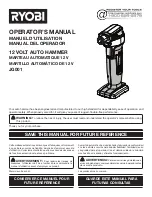
PXDIB-450
5. DRILLING
6. HELPFUL TIPS
FWD
REV
Before starting to drill, perform a few simple checks.
3 Secure the material to be drilled in a vice or clamp to stop it turning whilst
drilling.
1 Depress and release the variable
speed trigger to ensure it is not
locked on.
4 Hold the drill firmly and place the
bit at the point to be drilled.
2 Check the forward/reverse lever
is on desired setting.
5 Depress the variable speed
trigger to start the drill.
6 Move the drill bit into the workpiece.
Note:
Do not force the drill or apply side pressure to elongate the hole. Let
the drill do all the work.
3 Drill into the material until the surface reaches the start of the tape..
1 Measure along the drill bit to indicate
the desired depth
2 Wrap a small piece of masking tape
tightly around the drill bit.
Torque Settings
Drilling to a Preset Depth
Torque settings can alter the depth to which you can drill or drive into a surface. To
determine the torque setting required to drive a screw perfectly flush to the work
surface, follow the below steps.
A simple way of achieving a hole at a desired depth is to use masking tape.
When drilling hard, smooth surfaces, use a centre punch to mark the desired hole
location. This measure will prevent the drill bit from slipping off centre as you start the
hole.
When drilling metals, use light oil on the drill bit to keep it from overheating. The oil
will prolong the life of the bit and increase drilling action.
2 If the clutch rachets and makes
a clicking sound before screw is
flush, increase the collar setting and
continue tightening.
1 Set the torque collar
to lowest setting and
tighten the first screw.
3 Repeat until you reach
the correct setting/
screw depth. Use
this setting for the
remaining screws.






































